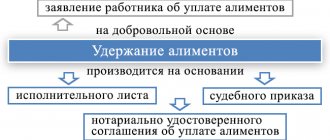Author of the article: Anastasia Ivanova Last modified: January 2020 3754
If a citizen is entrusted with the obligation to pay alimony, a certain percentage is calculated from his wages in favor of the claimant. Situations often arise when an employee is fired, or he decides to change his job. When the alimony payer is dismissed, he is paid all the benefits and compensation due for a particular case. Let's figure out from which payments due to the employee alimony is withheld upon dismissal.
Law on dismissal of alimony worker
The procedure for the employer's actions in the event of dismissal of the alimony worker is regulated by Art. 111 IC RF and Art. 5 No. 229-FZ. According to this article, a company that withholds alimony on the basis of a court decision or a certificate certified by a notary is obliged to report the dismissal of an employee to the executive authorities. The deadline for this is three working days. Also, the person receiving alimony - the second parent - is notified of the dismissal of the alimony provider. If the employer has information about the subsequent place of work of the alimony payer, he must provide this information too.
When moving from one place of work to another, the parent involved in paying child support does not have the right to hide the new place of employment. He must inform the bailiff and the person receiving alimony about the change of employer. Notification of additional earnings, if any, is also required. Failure to comply with these requirements may result in the responsible persons being subject to administrative liability.
Alimony from the unemployed in 2020 or 2019: how much to pay
In order to calculate the approximate amount of alimony payable from an unemployed person in 2020, you should proceed from the average salary and the cost of living in your region on the date of the decision to pay alimony, the same can be said about 2019. A certain share of this amount will be the answer to the question of how much to pay in the end! See these shares below, in the highlighted block of text. ⇓
As these indicators grow, the amount of alimony calculated on their basis will also increase. To be fair, it should be noted that this growth is quite low, only 3-7% per year.
As for the shares of income in which payments are calculated , in 2020 they will remain the same as in the past: 25% for one child, 33% for two and 50% for three or more children.
Also, the amount of payments from the unemployed may be determined by the agreement; in this regard, as of 2019, there are no changes.
This is important to know: Order on the timing of salary payment
In cases where a family breaks up, the most vulnerable party is the child. That is why the law requires both parents to support the child until he comes of age, strictly limiting the cases that allow a reduction in the amount of alimony or exemption from paying it.
If you are a woman and want to know how to collect alimony, then watch this video:
In what cases can a child support worker be fired?
The fact that an employee is a child support worker does not protect him from dismissal . The employer has the right to dismiss such an employee, like any other, for the following reasons:
- evasion of fulfillment of assigned obligations;
- absenteeism;
- inadequacy for the position held;
- staff reduction.
Additional information
All this is described in detail by Article 81 of the Labor Code. If there are compelling reasons, the employer has the right to dismiss the alimony payer as well as an employee not burdened with monthly payments.
Dismissal procedure
Regardless of what was the reason for terminating the employment relationship between the employee and the employer - failure to fulfill labor obligations or the personal desire of the person to leave his position - the procedure for dismissing the alimony payer must be followed. For example, when removing a person from a position for absenteeism, the procedure will be as follows:
- identification of the fact of absenteeism and documentary evidence (memo, act, etc.);
- determining the reason for absenteeism - the presence or absence of valid reasons;
- registration of dismissal under the relevant article with making a note in the work book and personal file.
Because the presence of minor children who are entitled to monthly payments is not a “mitigating circumstance,” an employee can be dismissed according to the same scheme and on the same grounds as other employees. The only nuance can be considered an increase in bureaucratic procedures and mandatory compliance with the following formalities:
- drawing up and sending notices and writs of execution to bailiffs;
- sending a corresponding notice to the second parent receiving child support.
The employer is responsible for the timely provision of the specified documentation to the authorities.
Conditions for collecting alimony upon dismissal
Child support upon dismissal from work is paid exclusively for a child under 18 years of age and on the basis of:
- Court decisions.
- Notarial agreement.
In this case, payments upon dismissal are subject to the Decree of the Government of Russia dated July 18, 1996, number 841, which contains a list of income from which alimony must be collected. In other cases, alimony from dismissal compensation is not paid:
- For the maintenance of the spouse.
- For the maintenance of disabled parents.
- For the maintenance of an adult disabled child.
This rule is provided for by the Federal Law “On Enforcement Proceedings”.
How to create a notification?
As a rule, the HR department is responsible for preparing a letter to the bailiff service. The notice of dismissal of the alimony provider is drawn up strictly in accordance with the sample. Only in this form will it be accepted for consideration. The document is drawn up in the application format. It must contain:
- table of contents or “header” of the document;
- date of dismissal of the employee and termination of employment;
- the position held by the employee before termination of the contract;
- amount of payments.
The notice of dismissal of the alimony provider is marked with: date, signature and seal.
It is also necessary to take care of timely notification of the employee’s wife (husband). The other parent and child have a legal right to know the work status of the person paying child support. Such a notification indicates on what date and on what grounds the alimony payer was dismissed, and therefore transferred from the status of “payer” to the status of “debtor”.
At the top you should indicate the name of the organization itself, followed by information about the recipient - in whose name the notification is written. For example, “To the bailiff in the OSP for the Zelenograd joint-stock company.” Then the next line indicates the last name, first name and patronymic of the person receiving alimony. For example, “To the collector of alimony, Surina Irina Nikolaevna.” Below is the phrase “Message about the dismissal of an employee.” The subsequent text in the notice reflects information about the reason for the dismissal of the alimony worker, for example, under the article or at his own request. If the employment contract is terminated due to absenteeism or neglect of assumed obligations, then the letter indicates the article under which the employee was dismissed.
Reducing the amount of alimony for those who have lost their jobs: methods and reasons
Despite the obligation to support the child until adulthood, the law provides for the opportunity for the alimony payer to reduce its amount.
Thus, the Family Code indicates that it is possible to reduce alimony or be exempt from paying it if the payer’s family or financial situation has changed (for example, the payer lost his ability to work due to some illness (and ended up unemployed), children appeared in the second marriage, etc.). To do this, you need to file a corresponding statement of claim with the court, in which you must indicate exactly what circumstances prevent payments from being made in the same volumes.
When considering the case, the court will take into account the financial and family situation of each party, as well as other circumstances important to the case.
This is important to know: What payments are due to pensioners when staffing is reduced?
What other methods can you use to pay less?
- The simplest and most difficult at the same time is to come to an agreement with your ex-wife. You can offer her to pay a smaller amount, but help with the child more often: meeting her after school, taking her to activities, picking her up on certain days, buying food, clothes, etc. A good relationship with the ex-wife is very important here, because if the amount of child support has already been established in the same amount, but in fact is paid in less, she has every opportunity to go to court to recover the underpayment. The solution here may be to obtain receipts from the child’s mother, where the required amount will be indicated.
- Some alimony payers who have children from a current marriage use a rather risky way to reduce alimony by turning the current wife to court, since modern legislation does not prohibit married spouses from demanding funds for child support through the court. So, if a parent has two children, one from each marriage, the court will withhold 33% of all income from them. This means that only 16% will go from the budget for a child living separately instead of 25%.
- If the child has property that generates income, you can try to use this to justify your demands for a reduction in child support payments, even if you are not unemployed.
- If the payer has reason to believe that he is not the biological father of the child, then by challenging his paternity in court, he will be released from alimony. But the main thing here is to prove that you were not aware of this fact at the time of the birth of the child.
Termination of alimony payments
Expert opinion
Polyakov Pyotr Borisovich
Lawyer with 6 years of experience. Specialization: civil law. More than 3 years of experience in drafting contracts.
Article 120 of the Family Code (as of 2019) lists all the grounds upon the occurrence of which the obligation to pay alimony can be considered terminated. These include:
- For alimony paid by agreement:
- death of one of the parties;
- expiration of the agreement;
- the occurrence of an event that is provided for in the agreement as a basis for termination of payments.
- For alimony ordered by the court:
- death of the payer or child;
- the child's coming of age;
- adoption of a child.
As you can see, there is no reason to lose your job, so you cannot count on a complete cessation of payments just because you “don’t have a job.”
How to send a notice to the bailiff service?
In Art. 111 IC RF and Art. 5 No. 229-FZ states that the employer is obliged to send a notice to the bailiffs within three days from the date of dismissal of the alimony worker. However, there is no exact time frame for returning the writ of execution. The best solution would be to send the documentation the next day after dismissal. There is no point in delaying this, since untimely notification of executive authorities about the removal of an employee from position is punishable in accordance with Part 3 of Art. 17.14 Code of Administrative Offenses of the Russian Federation:
- a fine of 15-20 thousand rubles for an official who neglects his obligations;
- a fine of 50-100 thousand rubles, which is imposed on an organization for late notification.
You can provide all documents to the bailiffs by mail - registered mail with notification. In exactly the same way, a letter is sent to the second parent – the child support collector.
Sending a notice to the bailiffs
Article 111SK states that the employer must send a notice to the executive organization within 3 days from the date of dismissal of the employee. But there are no clear deadlines for the return of the writ of execution. The best solution is to send a notice on the second day after the employee is released from his position. There is no need to delay, since penalties are provided , taking into account Article 17.15 of the Code of Administrative Offenses:
- a fine of 60-110 thousand rubles, which is paid by the enterprise for late notification;
- a fine of 10-25 thousand rubles for an employee who neglected his obligations.
You can submit all documentation to the executive service by mail. A letter is sent to the alimony recipient in the same way.
What should an accountant do?
After the dismissal of the alimony worker, the accountant needs to do important work - collect a personal file and send it to the company’s archives. The following documents should be placed in your personal file:
- a copy of the writ of execution, which contains information about funds withheld from wages and the balance of payments;
- a duplicate of the dismissal order;
- copies of notification letters sent to the executive authorities and to the second parent;
- a list of papers that make up a personal file.
If the company has a documentation log, then a corresponding note is made in it, the date of dismissal and sending of documents is indicated.
Retroactive dismissal of an employee
It often happens that the alimony payer introduces ambiguity into the issue of employment, dismissal or continuation of work in the same place. For example, he repeatedly plans to submit his resignation and then changes his mind. A company manager may be faced with a difficult question regarding what to do if an employee is fired retroactively. After all, in fact, we are dealing with a violation of the law in the form of delays.
For untimely submission of a writ of execution and some other inconsistencies, the employer may be punished with a fine. Therefore, it is extremely important to correctly explain the reason for the untimely submission of documents to the executive bodies. If an employee regularly committed unlawful acts, failed to fulfill assigned obligations, or was noted for absenteeism, the employer can fire him on his own initiative by applying the article. In this case, the retroactive dismissal of the alimony payer cannot be considered a violation of the law.
Amounts of alimony payments for the unemployed
In what amounts should alimony be paid if you are fired, if the debtor does not work (or works “in the dark”)?
This is determined by exactly how the relevant duty was established:
- Agreement on payment of alimony. In this case, all issues regarding the payment of alimony depend entirely on the parties themselves.
- By court decision. Such alimony can be paid in the form of:
- a fixed amount of money;
- percent of the payer’s income;
- a fixed amount and interest at the same time.
It is alimony in a predetermined amount that is most often prescribed by the court when a parent turns out to be unemployed or “gets by” doing odd jobs or working unofficially. Most often, the basis in such cases is the cost of living and the average salary, which depend on the region of residence of the alimony recipient. When assigning the amount, the number of children whom the alimony payer is obliged to support is also taken into account.
Payment of alimony cannot be canceled in any way due to lack of work , so amounts not paid on time accumulate in the form of a debt that can be collected through the debtor’s property.
If the alimony payer quits or is fired, and in fact does not have a job (is unemployed) and is registered with the employment service, the court may establish alimony as a share of the benefit received. However, if the second party can prove that the benefit is not the only type of income, and the debtor has other regular income (for example, from renting out housing), the court may additionally award alimony in a fixed amount.
Nuances
The dismissal of an alimony payer does not mean the termination of payments. After delivering a letter of termination of the employment contract to the second parent, he has the right to control the situation by inquiring about the receipt of information about the new place of work from the bailiffs.
A notification letter must be sent to the parent on the day of termination. Timely information is clearly regulated by law. A delay of even one day may be grounds for filing a complaint.
Alimony payments
The situation becomes somewhat more complicated if the alimony worker decides to resign from this enterprise:
- Firstly, there is a need to transfer the writ of execution to the address of the alimony worker’s new job.
- Secondly, the dismissal procedure involves the accrual of a number of payments to the employee, from which deductions must also be made for alimony:
- wages for time worked in the last month;
- vacation pay, provided that there is unused regular vacation;
- severance subsidy if the termination of the employment contract was initiated by the employer.
A large number of employees have understandable questions about exactly how deductions should be made from final payments accrued upon dismissal. Is the calculation made from the total accrued amount, or is there a separate calculation for each payment?
The legislation in force in the Russian Federation offers ready-made answers to all these questions. This will be discussed further in our article.








